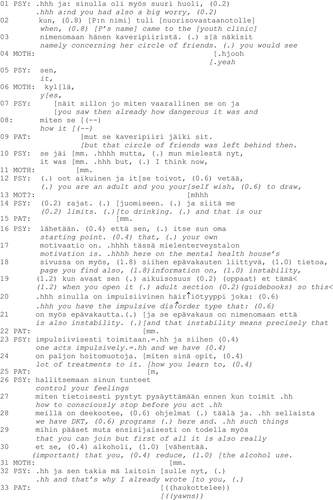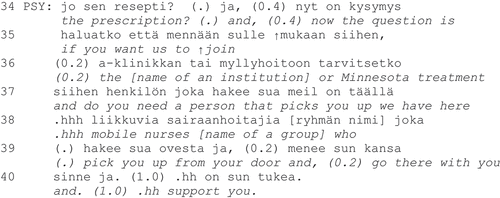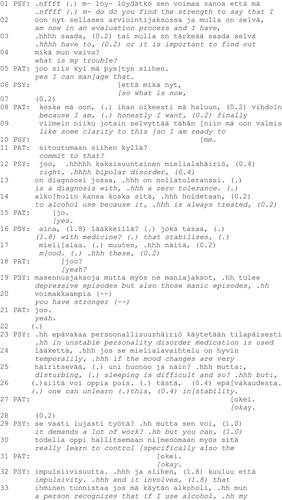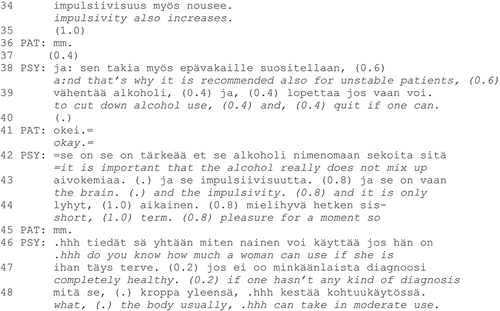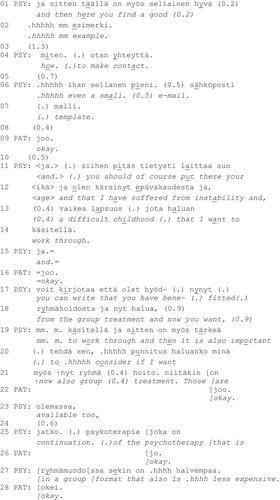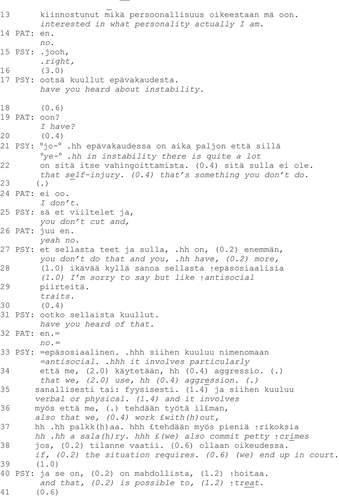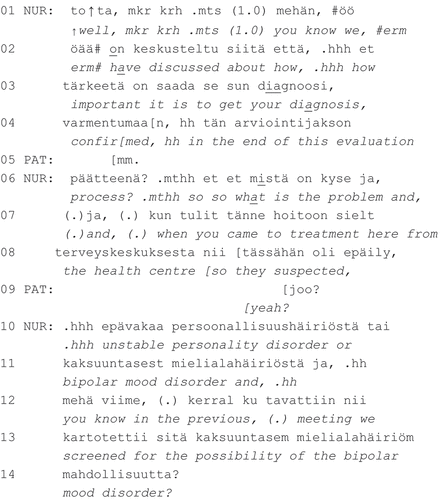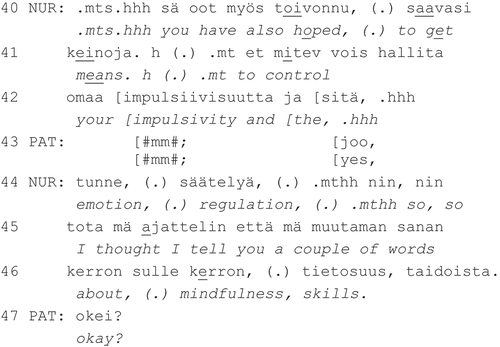ABSTRACT
A personality disorder (PD) diagnosis can be considered by a patient to be stigmatizing. This presents interactional challenges for the clinician who makes the diagnosis and communicates it to the patient.Through an analysis of video-recorded clinical interviews of PD patients, we explore the anticipation and delivery of the diagnosis in psychiatry. The method of the study is conversation analysis (CA). The diagnostic evaluation process of each patient extends over a number of clinical interviews. At the beginning of the process, the clinicians speak about the personality disorder diagnosis in an anticipatory manner. At the end of the process, they eventually communicate it to the patients. This analysis focuses on the interactional practices used by psychiatrists to help a patient “save face” when mentioning the (prospective) diagnosis. We demonstrate that both the avoidance and corrective practices of face work occur in the data. Even with these prartices, the delivery of the diagnosis to the patent can lead to conflict. We conclude that, in extended diagnostic evaluation processes, the preparatory work by the clinician is important to secure patient participation.The data for this analysis are in Finnish.
In psychiatry, personality disorders (PDs) are defined not only in terms of mental functioning but also in relation to social norms and expectations. The diagnostic manual of the American Psychiatric Association (APA) defines personality disorders as “an enduring pattern of inner experience and behavior that deviates markedly the expectations of the individual’s culture” and leads to distress or an impairment (APA, Citation2013, p. 645). Although psychiatric diagnoses are part of the standard practice of medicine and these diagnoses help patients to seek appropriate treatment for their mental suffering, a PD diagnosis that implies social deviance by definition constitutes a stigma: a “blemish of individual character” (Goffman, Citation1963, p. 4). This is one of the reasons why PD diagnoses have been contested (e.g., see Proctor, Citation2007). Furthermore, a survey study of borderline PD patients reports their experiences of discrimination and negative attitudes in health care (Lawn & McMahon, Citation2015). This means that the delivery of a PD diagnosis obviously presents an interactional challenge for doctors and other clinicians who participate in the diagnostic process. In terms of what Goffman (Citation1955) referred to as face work, we can expect that clinicians resort to interactional strategies to protect the patient’s image of self while delivering diagnostic information on PDs.
Goffman introduced the concept of stigma as follows:
While the stranger is present before us, evidence can arise of his possessing an attribute that makes him different from others in the category of persons available for him to be, and of a less desirable kind. … He is thus reduced in our minds from a whole and usual person to a tainted, discounted one. Such an attribute is a stigma, especially when its discrediting effect is very extensive. (Citation1963, pp. 11–12.)
Within the fields of sociology and psychiatry, mental health disorders have long been discussed as a stigma (Gray, Citation2002; Link & Phelan, Citation2014). Despite efforts to make mental health problems less stigmatizing (e.g., see Abbey et al., Citation2011), PDs in particular continue be considered as a stigma, as a facet of identity that makes the self less worthy than it would otherwise be. Goffman (Citation1963, p. 4) described one type of stigma as “blemishes of individual character.” As we have demonstrated elsewhere, the standard medical interview that determines a possible PD involves questions and answers regarding the patient’s “bad behaviors,” which indeed can be regarded as indications of Goffmanian “blemishes of character” (see Peräkylä, Citationforthcoming).
Given the stigmatizing nature of a PD diagnosis, it is understandable that communicating this diagnosis poses an interactional challenge for clinicians. In order to maintain the necessary working alliance with patients, clinicians need to engage in face work to protect a patient’s positive self-image (Goffman, Citation1955). One key form of the face work identified by Goffman (Citation1955, pp. 217–219) is for the clinician to avoid topics or activities that would lead to an expression of damaging information. Another key form is correction, which involves acknowledging the incident that threatens the social worth of a participant and making an effort to correct its effects. As we will demonstrate, psychiatric encounters have both avoidance and corrective processes in relation to diagnosing the PD diagnosis. We also aim to highlight the potential problems in these strategies. As earlier research from other contexts (e.g., see Bull & Fetzer, Citation2010; Clifton, Citation2012) has suggested, conversation analysis (CA) is a sensitive method to analyze the actual practices of face work.
Our analysis focuses on the delivery of a PD diagnosis. Earlier CA research has extensively explored interactions in somatic medicine (Gill & Roberts, Citation2012), diagnosis delivery (Heath, Citation1992; Peräkylä, Citation1998, Citation2002, Citation2006) and treatment recommendation (Stivers & Barnes, Citation2018; Stivers et al., Citation2018). Most importantly for the present analysis, studies have reported that the medical diagnosis can be given as a solid “diagnostic moment” (Jutel, Citation2014) or as something embedded in other actions (Heritage & McArthur, Citation2019).
In terms of past research, the interactions that occur in psychiatry have been less investigated. Although there have been earlier studies on treatment recommendation/negotiation in psychiatry (e.g., Bolden et al., Citation2019, Citation2020; Hamann et al., Citation2016; Kushida & Yamakawa, Citation2020) and on the orientation to a patients’ life world in the context of the psychiatric diagnostic interview (Savander et al., Citation2019, Citation2021; Weiste et al., Citation2018), the actual delivery of a psychiatric diagnosis has not been previously analyzed. However, related CA research has been conducted on the diagnosis of autism in psychiatry (Turowetz & Maynard, Citation2017, Citation2019), on depression in primary care (Ford et al., Citation2020), and on the diagnosis of dementia in memory clinics (Dooley et al., Citation2018). In line with these earlier studies, our study contributes to the CA of medical interactions by exploring further two aspects of psychiatric diagnosis: (a) the practices through which clincians, in early phases of the assessment process, anticipate the imminent diagnosis, and (b) the actual delivery of a face-threatening diagnosis. Increasing the current knowledge on these practices has clinical implications for improving clinical communication and patient participation in psychiatry and other medical care. We also hope that our findings are relevant to medical sociologists interested in the division of the work between doctors and nurses (e.g., Svensson, Citation1996).
Our analysis examines talk about the patient’s diagnosis in the context of the psychiatric assessment process, which in our data extends over a number of clinical interviews. During the initial stage of the assessment process, the PD diagnosis is spoken about in an anticipatory way, as a possibility. At the end of the assessment process, the PD diagnosis is eventually communicated to the patient. Our focus is on the interactional practices adopted by the psychiatrists to protect a patient’s self-esteem.
Data
The data of the study consist of video-recordings of the diagnostic evaluation processes in a psychiatric outpatient clinic in Finland. From a data set of 12 evaluation processes, five cases were selected for this study. The selection criterion was that, in these cases, the clinical records showed that the patient was eventually diagnosed as having a personality disorder. For each patient, the evaluation process consisted of five to 10 clinical interviews conducted by a psychiatrist and a psychiatric nurse or psychologist, or a psychiatric nurse or psychologist alone. The duration of one interview was 45 to 60 minutes, and the interviews normally occurred at intervals of one or two weeks. The research project was approved by an ethics committee of the relevant university hospital, and informed consents by participants were obtained.
Psychiatrists led the initial interview (in one case, the two first interviews) and the last interview. These were all medical doctors with a specialization in psychiatry, and they did not have psychotherapeutic training. The other clinician—who usually was a psychiatric nurse, but sometimes a psychologist—participated in all interviews and conducted his or her own interviews between the first and the last by the psychiatrists. The aim of the interviews conducted by the psychologist or psychiatric nurse was to gather information to determine the diagnosis and to recommend treatment. It appears that the interviews also had a therapeutic function (for example, in terms of emotional support), although that was not the primary purpose of these meetings. One part of this evaluation also involved standardized questionnaires. The last interview (referred to as the treatment negotiation) involved the delivery of the diagnosis and the recommendation for treatment. Our analysis focuses primarily on the encounters with the psychiatrist present, and particularly on how the psychiatrist refers to or delivers the diagnosis. However, it is important to note that the course of the encounter is affected by the presence of the psychiatric nurse or psychologist during the treatment negotiation as well as by the nature of the common ground the psychiatric nurse or psychologist has established with the patient. We return later in this analysis to the role of the psychiatric nurse or psychologist in terms of anticipating the diagnosis.
The original data are in Finnish and were translated into English by the authors. Some aspects of the language use (such as minor language errors by nonnative speakers) were lost in translation. Nonetheless, within the translations we have attempted to preserve the dysfluencies in talk that occurred in the Finnish original, although some adjustments have been made to comply with idiomatic English. We have also used prosodic transcription symbols in the translations (such as intonation), even though we are aware that the syntactic and prosodic differences between the two languages make the accurate translation of prosodic details exceedingly difficult.
Anticipating the diagnosis: Reference to the PD embedded in other topics
During the patients’ first meetings with their psychiatrists, the psychiatrists tended not to topicalize the possible PD as such, but the reference to the PD was embedded in other topics. This was one means for the psychiatrists to avoid topics their patients found to be face-threatening. Furthermore, when referring to the PD, instead of providing detailed information on the disorder, the psychiatrists recurrently advised their patients to consult a mental self-help Web service to read about the PD.
We examine two cases that refer to the diagnosis embedded in other topics and actions. In both cases, the other topic is the patient’s use of alcohol. In the beginning of the first extract, the psychiatrist and the patient’s mother (who also attends the first consultation) discuss the mother’s worry over the patient’s circle of friends. In line 10, the psychiatrist shifts the topic back to the patient’s alcohol use, which they had discussed earlier in the meeting. The patient is in her early 20s.
Extract 1 (P1K1) PSY=Psychiatrist; MOT=Mother; PAT=Patient
In line 10, the psychiatrist begins to talk about the patient’s motivation to reduce her alcohol consumption, and states that this change constitutes the “starting point” of her treatment (line 16). After the transition relevant point in line 17 (although the grammatigal structure is incomplete, the psychiatrist recycles the point regarding the patient’s personal motivation to reduce her use of alhocol and speaks in completion-implicative prosody), the psychiatrist breathes in, indicating that she intends to continue talking. She then refers to the Website of a public online service for mental health, informing the patient that this service also has information on “instability” (i.e., on the emotionally unstable personality disorder; lines 17–19). At this point, the psychiatrist mentions the prospective diagnosis first in the context of recommending Websites.
Continuing in that context of talking about websites, in lines 20–21 and 23 the psychiatric proceeds to name the diagnosis by approximating the wording of the International Classification of Diseases (ICD 10; emotionally unstable personality, impulsive type). The psychiatrist apparently makes the diagnosis at the beginning of the assessment process by referring to the tentative diagnosis that was included in the referral letter from a primary health-care professional. It should be noted that the psychiatrist does not mention the word “personality” when referring to the PD but uses instead the expressions “instability” (line 18) and “impulsive disorder type” (line 20). A transition relevant place occurs in line 21, but a full response by the patient is not made relevant because the psychiatrist’s advice concerning the use of the Website (starting in line 19) appears to be in progress. The patient responds minimally (line 22), which is followed by the psychiatrist’s explanation of the meaning of the diagnosis (instability means precisely that one acts impulsively, lines 21, 23). Thereafter, the psychiatrist “rushes through” (note the inbreath in line 23) to discuss the treatment (lines 23–24, 26–29). Then, in line 29, without leaving room for the patient to respond, the psychiatrist returns to the issue of alcohol use. The talk about alcohol use leads to a question posed to the patient (concerning her preferences regarding the arrangements of a visit to a center for addiction treatment; lines 34–40), which the patient eventually answers (data not shown).
The psychiatrist’s anticipation of the PD diagnosis is embedded in her advice on the self-help service and in the broader context of discussing alcohol consumption. During the topical shift from alcohol to PD and back to alcohol, the psychiatrist does not invite the patient to respond. Thus, the psychiatrist does not topicalize the PD but offers information about it as a side issue to the theme of alcohol use.
The next extract is from the first meeting of another patient. It illustrates how the PD diagnosis is anticipated in the context of talking about the patient’s alcohol use and treatment.
Extract 2 (P4K1)
In the beginning of the extract, the psychiatrist inquires as to whether the patient has the strength to stop drinking alcohol to enable the diagnostic process (lines 1–4). The patient agrees with the psychiatrist’s suggestion (lines 5, 8–9, 11), asserting her motivation and commitment. The psychiatrist subsequently specifies how the different diagnoses (bipolar disorder and “unstable personality disorder,” meaning the emotionally unstable personality disorder) are treated with regard to alcohol use (lines 12–14, 16–17, 19–20, 23–25). In this context, the psychiatrist also mentions the nonmedical treatment of an unstable personality in terms of how one can “unlearn it” (lines 26, 29–30). A transition relevant place occurs at the end of line 26, but the psychiatrist’s account appears to still be in progress: the statement on the possibility to unlearn the PD projects continuation (specification). The patient responds minimally in lines 27 and 31, receiving the information regarding her treatment. The psychiatrist then shifts the topic from the PD back to alcohol (line 32). The transition relevant place in line 32 is followed by the psychiatrist’s in-breath, indicating that the psychiatrist intends to continue talking. As in the previous extract, the psychiatrist neither fully topicalizes the PD nor invites the patient to respond to the prospective diagnosis.
These two extracts are cases that make reference to the prospective diagnosis occurring in the context of discussing alcohol use. They present examples of an avoidance strategy that is used in face work. Toward this end, the reference to the PD was embedded in another topic, which meant that the patients were not pressured to respond to the diagnosis. On the other hand, this practice left the patients little space for a nonminimal response if they wanted to comment on the possible PD diagnosis. In both cases, it is possible that the PD had been mentioned previously in the patients’ earlier contacts with health-care professionals (who sent the referral letters), but this is not indicated in our data. It appears that the anticipation of the diagnoses that occurred during the first encounter is based on the referral letter.
Let us now turn to how the PD diagnosis is talked about during the treatment negotiation at the end of the diagnostic process. We detected two types of context for talk about the diagnosis. The first has the diagnosis embedded in other actions, and the second has the diagnosis topicalized (creating a “diagnostic moment”).
Treatment negotiation: The diagnosis embedded in other actions
At the end of the assessment process, the PD diagnosis is most often mentioned when discussing the patient’s treatment. For these cases, the diagnosis is presupposed, taken for granted, and not actually topicalized. is an example of the pyschiatrist mentioning “instability” many times (i.e., an emotionally unstable personality disorder) during the treatment discussion with this patient and noting instability as something that the treatment will address. The patient is the same as in .
Extract 3 (P4K10)
Beginning from line 1, the psychiatrist offers the patient advice on how to contact a psychotherapist for further treatment. The psychiatrist advises the patient that she should mention in her e-mail that she has suffered from an emotionally unstable personality disorder (“instability,” line 12). This diagnosis comes as part of a list of information the patient should include in her application. Within the context of this activity (advice giving), the psychiatrist does not invite the patient to respond to her reference to the diagnosis, but subsequently alludes to the patient’s difficult childhood (“instability and, (0.4) difficult childhood,” lines 12–13). The reference to a difficult childhood can be interpreted as face work in terms of attributing the origins of the patient’s disorder to her childhood environment (a corrective strategy of face work).
A transition relevant place occurs in the end of line 14. As the primary objective of the psychiatrist is to advise or instruct the patient in composing an e-mail to a psychotherapist, the patient’s response to the diagnosis that was mentioned is not made relevant here. The patient does not take a turn, and the psychiatrist continues without any delay (line 15). The patient responds minimally in line 16, after which the psychiatrist continues to speak about what the patient could mention when contacting the psychotherapist. Thus, the diagnosis is mentioned in the context of offering advice concerning the treatment (psychotherapy) and is not actually topicalized. During the earlier meetings with a psychiatric nurse, the PD diagnosis had been suggested as a possibility, but during the assessment process with this patient, no actual diagnostic moment occurs.
During that encounter, it is therefore possible to confirm the PD diagnosis as a side activity in the context of another action that occurs during the meeting to negotiate the patient’s treatment. This points again to an avoidance strategy used in face work. However, we also have two cases in the data in which the PD diagnosis is topicalized and a proper diagnostic moment arises. For these cases, the patients resist the diagnosis. In both cases, a psychiatric nurse who is also present in the treatment negotiation participates in the discussion of the patient’s diagnosis.
Treatment negotiation: Diagnostic moment
is a case from a treatment negotiation in which the patient is explicitly and openly diagnosed with a PD. The patient is disengaged throughout the diagnostic sequence. We have analyzed this disengagement in more detail elsewhere (Peräkylä et al., Citation2022) and will here include only the key parts of it. In the beginning of the extract, the psychiatrist is talking with the patient’s mother about the patient’s social circle, which consists of marginalized people. In line 11, the psychiatrist begins to address the patient with a question regarding her interest in her own personality. This shift in topic indicates that the PD diagnosis is imminent. The patient is the same as in .
Extract 4 (P1K8)
The psychiatrist does not use prosodic or lexical means to mark the shift in topic but, rather, ties her turn to the previous topic by stating and (line 11). The patient responds minimally and in the negative (line 14) to the question concerning her interest in her own personality, not marking her dispreferred response with any delay or hesitation. She therefore blocks any possible elaboration on this topic. After receiving the patient’s response (line 15) and a three-second gap (line 16), the psychiatrist continues with a topic proffer (Schegloff, Citation2007, p. 169) in line 17. The patient responds again minimally, producing a “pro forma go-ahead” (line 19) but without displaying any interest in the topic. The information delivery of “instability” (i.e., the unstable personality disorder) ensues (lines 21–22). The psychiatrist presents this as a disorder that the patient does not have. As a reason for this exclusion of “instability,” the psychiatrist refers to the patient’s lack of symptoms (self-injury, line 22). As the absence or presence of self-injury is information to which the patient has primary access (see Pomeranz, Citation1980), the psychiatrist’s remark strongly invites the patient’s confirmation, which the patient provides in line 24. However, the patient responds in a disengaged manner that is minimal and prosodically flat.
Within the same extract, the psychiatrist expands her turn by offering an example of self-injury (cutting, line 25), but the patient continues with her minimal, prosodically flat response (line 26). Eventually, in lines 27–29, the psychiatrist delivers the diagnosis of “antisocial traits,” which apparently involves an allusion to the ICD 10 diagnosis of “dissocial personality disorder.” By softening the delivery of the diagnosis (“I am sorry to say” in line 28), the psychiatrist acknowledges the face-threatening and stigmatizing quality of this particular diagnosis. The patient first reacts to the diagnosis in silence (line 30), and the psychiatrist subsequently pursues the patient’s response by asking whether she has ever heard of that (line 31; see Dooley et al., Citation2018), and the patient answers with a minimal “no” (line 32).
Even though the patient’s minimal answer indicates that she is not motivated to listen further, the psychiatrist describes the symptoms of antisociality (lines 33–38). The symptoms the psychiatrist mentions—displaying aggression (lines 34–35), working without a salary (i.e., working off the books and not paying taxes; lines 36–37), petty crimes (lines 37–38), and ending up in court (line 38)—match the behavior the patient had revealed about herself during the assessment process (thus offering evidence for the diagnosis, see, Peräkylä, Citation2002). However, the patient does not offer an acknowledgment (such as mm-hm, yes, or a nod) of these symptoms. An assertion regarding the treatability of the disorder follows in line 40; the patient continues to remain silent (lines 41).
In , the psychiatrist topicalizes the PD diagnosis through multiple turns, making an acknowledgment and/or an elaboration of the diagnosis strongly relevant. She also engages in corrective face work that softens the delivery of her diagnosis (line 28). Despite her interactional work to facilitate the patient’s participation, the patient remains disengaged throughout the talk concerning the diagnosis. Besides her lack of verbal responses, the patient’s disengagement is exhibited in her gazing away as well as in her auto-involvement, such as looking at her nails (for a more elaborated analysis of this case, see Peräkylä et al., Citation2022). All in all, the patient withholds relevant responses and other displays of participation during the psychiatrist’s delivery of her personality diagnosis. In this manner, the patient indirectly but nonetheless rather discernably resists the diagnosis.
The next extract is another case from our data that has a diagnosis that is explicitly delivered at a diagnostic moment. Prior to this extract, the psychiatrist informed the patient that the problem was her “personality.” The patient disagreed with this assessment, claiming that she did not see any problem, even if others might see it. After that discussion, the psychiatrist picks up her papers from her desk and, looking at them, resports what the referring doctor stated concerning the patient’s diagnosis (lines 1–3). The actual diagnosis ensues using medical categories (beginning in line 5). The diagnostic talk is framed as an announcement of what the psychiatrist intends to write in the medical records (rather than her delivering the information directly to the patient). This design portrays the diagnosis as not being contingent upon the patient’s acceptance.
Extract 5 (P7K6)
The psychiatrist makes two diagnoses: The first is a “mixed anxiety-depressive state” (line 3) as an initial condition, and then the “other personality disorder” (lines 10–11) as the actual diagnosis. As in , the psychiatrist also includes an embedded apology in the delivery of the diagnosis by presenting the recording of her diagnosis as an obligation (“I will have to put there”; line 10). After the psychiatrist has clarified the diagnosis by referring to her earlier talk (line 12) about a problem in the patient’s personality (data not shown), the patient receives the diagnosis with a minimal “yes” in line 14. The psychiatrist subsequently continues to clarify and elaborate on the meaning of the diagnosis by rephrasing it (or a key dimension of it) as “this problem with emotion regulation” (line 16). Although the patient’s problem in regulating her emotions is presented as known-in-common and as accessible to both parties (see “this” in line 16), the patient does not express an acknowledgment of it during the ensuing silence of three seconds (line 17).
Moving to nonmedical, experience-near language, the psychiatrist continues her clarification by an account of the patient’s preference for being in a “fog” and not wanting to see (lines 20–21). The patient likewise receives this account minimally (line 23). In this context, the Finnish response particle “okei” is possibly a more neutral information receipt than “nii” or “joo,” which convey epistemic relations and agreement (see Couper-Kuhlen, Citation2021; Sorjonen, Citation2001), and thus “okei” may be heard as projecting possible disagreement. The psychiatrist then expands her elaboration of the diagnosis by suggesting a reason for the patient’s preference for being in fog: Things that she might acknowledge are very difficult (lines 24–27). The patient does not respond during a one-second silence (line 28), and the psychiatrist expands her turn (line 29), providing further evidence to the existence of a problem (the environment can see it). The patient responds again by stating “okay” in line 31. The psychiatrist once again formulates her account of the patient’s problem by pointing out her willingness to forget difficult matters (lines 34–35) and to recognize the problem in others rather than in herself (line 37), which is followed by a five-second silence (line 40).
In the excerpt, the psychiatrist first uses medical terms to deliver the diagnosis of the PD (lines 10–11, 16) and subsequently uses layperson’s terms to explain and clarify it (between lines 18 and 37). This latter account involves an evaluative component: The psychiatrist describes the patient’s behaviors as bad and problematic. The patient’s passivity in light of the psychiatrist’s account of her behaviors constitutes passive resistance toward it. In other words, as the “owner of experience,” the patient would be expected to confirm or disconfirm the account (Labov & Fanshel, Citation1977; Peräkylä & Silverman, Citation1991).
Eventually, in line 41, the patient openly disagrees with the psychiatrist’s account of her behaviors. As that account involved a negative evaluation of the patient’s behaviors, the disagreement would be conversationally preferred (Bilmes, Citation1988). Yet, in the context of medical consultation and diagnosis delivery, the psychiatrist can claim epistemic authority. This is precisely what the psychiatrist does in lines 47–48 where, in response to her patient’s disagreement, the psychiatrist states that she will stick to her evaluation (lines 47–48).
To summarize, in the psychiatrist openly delivered the diagnosis of her patient’s PD and this instigated the patient’s resistance—first passive and then open—and the participants ended up having a disagreement. The psychiatrist prepared the delivery of the diagnosis through conducting face work—that is, the psychiatrist achieved this by clarifying that this was something that was not contingent on the patient’s acceptance (an avoidance strategy), and by presenting the recording of the diagnosis as her obligation (a corrective strategy). Nevertheless, as we have seen, this face work does not prevent disagreement. In their further interaction (data not shown), their disagreement remained unsolved.
Topicalization of the PD diagnosis in an encounter with a nurse
and are cases of the PD diagnosis being topicalized and involving some means of face work, although that led to a conflict between the psychiatrist and patient (in in terms of disengagement and in in terms of overt disagreement and resistance). These were the only cases in our data that had the PD diagnosis topicalized during the negotiation of treatment. This means that we did not have a case of the psychiatrist topicalizing the diagnosis and the patient agreeing with that diagnosis. Nonetheless, the prospective diagnosis is also discussed in the meetings with a psychiatric nurse or a psychologist during the diagnostic process. is a segment from an encounter between a psychiatric nurse and a patient. Although the patient remains relatively passive, the topicalization of the diagnosis does not lead to a conflict. The patient is the same as in and .
Extract 6 (P4K4)
Prior to this extract, the nurse closed the previous topic (drug test results), and in the beginning of the extract, she launches a new topic: the diagnosis. The nurse carefully introduces that topic by referring to their common ground, which is that the participants have discussed the importance of confirming the diagnosis within the evaluation period (lines 1–4, 6). The nurse formulates her assertion as common knowledge such that diagnoses that were examined during the process were the emotionally unstable PD and the bipolar disorder (lines 7–8, 10–11). The nurse then prepares the delivery of the prospective diagnosis by stating that it does not appear to her that the patient would have bipolar disorder (lines 12–14, 16–18, 21). At this point, the nurse hesitantly states her viewpoint (“I get more the kind of impression that … ”, line 24) that the “problem is more on the side of personality” (lines 24–25). The patient responds in overlap with joo/okay in line 26.
Without leaving space for the patient’s further response (using a flat prosody as well as “and” in line 25), the nurse continues her turn in line 25 by explaining the disorder to the patient in terms of its development (lines 27–28). The nurse’s expressions “for some reason” (line 27) and “over time have developed” (lines 27–28) do not place the blame on the patient but, rather, present the disorder as something that resembles an independent agent that has its own logic and course of development and, as it were, affects the patient. The patient responds by stating “mm.” in line 29.
The nurse then mentions the patient’s problematic behaviors and experiences (lines 30–31, 33–34, 36–37), which she portrays as consequences of that disorder. Thus, the problematic behaviors the nurse identifies also serve as evidence for the patient’s diagnosis (Peräkylä, Citation2002).
In terms of managing potential resistance, it is noteworthy that the nurse explicitly presents the symptoms as those the patient herself reported to her (l. 30: “those sudden mood changes”; lines 34, 36: “impulsivity that you spoke about here”). The patient responds by using acknowledgment tokens in some of the symptom descriptions (line 32, 35). There is a place for a more extended response in line 38 after the nurse has pointed out that the problems the patient reported are “very typical symptoms related to that” (line 36–37). The patient, however, responds only minimally, possibly orienting herself to the nurse’s just prior talk more as information concerning symptoms than as personalized news about herself. The nurse does not pursue a more elaborated response but moves on to talk about the patient’s treatment (from line 40), maintaining the reference to what the patient herself presented during the process. Although the patient responds only minimally, the participants remain in agreement on the diagnosis and the treatment, and the patient neither displays disengagement nor openly resists the suggested diagnosis.
Comparing the conflictual diagnosis deliveries in and and the nonconflictual , the clinicians’ stances appear different. In and , the clinicians displayed hesitation in their delivery of the diagnosis (“I’m sorry to say,” “I have to put”), indicating that they considered the diagnosis to be problematic news. In , however, the clinician portrayed the patient as a “sufferer” of symptoms, which were explained by the diagnosis (so that the diagnosis appears as neutral or even good news). In both patterns, the clinicians attended to the patient’s self-image. In the former pattern, the clinicians acknowledged the damage that their news was causing. In the latter pattern, the positive self-image remained intact, as the patient was portrayed as a victim rather than an agent of the problematic experiences associated with the PD. This difference in the manner of delivering and designing diagnostic information might have, in part, contributed to the difference in the patient’s responses.
It is thus possible to topicalize the diagnosis without creating conflict. This might be easier in the meetings with a psychiatric nurse or psychologist, as it is not yet the final diagnosis given by a doctor. This type of preparatory work, however, can help psychiatrists discuss a diagnosis indirectly as a presupposition, as seen in .
Discussion
Our analysis of clinician–patient interaction revealed the intereactional problems encountered in delivering diagnostic news related to PDs. Clinicians often provide information concerning the diagnosis indirectly, avoiding the topicalization of it. We also presented two cases in which the clinicians eventually topicalized the PD diagnosis, and in these cases, the patients ended up resisting the diagnosis. When the clinicians avoided topicalization as well as open topicalization, their processes of face work could be observed. For the former cases, the “avoidance process” was adopted (Goffman, Citation1955, p. 217), whereas in the latter cases, the “corrective process” was used (Goffman, Citation1955, p. 219).
Even though the open topicalization of the PD diagnosis would, in principle, be clinically justified, the patients’ resistance to the diagnosis being openly delivered is evidence that openness can backfire. The prospect of patient resistance suggests that psychiatrists’ avoidance of openly topicalizing the diagnosis has its rationale. The division of work between the clinicians (the psychiatrist only briefly mentioning the diagnosis that the psychiatric nurse or psychologist discussed more deeply with the patient) appears to enable the psychiatrist’s avoidance strategy.
We acknowledge that treating a stigmatizing diagnosis as a side issue in the beginning of the evaluation process is a means to allow more interactionl space for the major tasks of the clinicians. These tasks include eliciting information from the patient and securing the patient’s commitment to the process (which also involves other changes in behavior, such as reducing alcohol use, to enable the diagnostic evaluation). At the end of the evaluation process, a key task is to secure a patient’s commitment to the prospective treatment (see Ford et al., Citation2020 on a patient’s resistance to a diagnosis of depression).
Our study suggests that during extended diagnostic processess, it is important that the clinician undertake preparatory work to secure patient participation when they discuss the treatment. This is in line with the results of the earlier CA on diagnosis (Peräkylä, Citation1998; Savander et al., Citation2019, Citation2021; Turowetz & Maynard, Citation2019; Weiste et al., Citation2018) that underscored the importance of sensitivity to the patient’s perspective as well as of constructing a common ground of knowledge (see also Weiste et al., Citation2020). Our study highlights the diagnosis as a longitudinal process that is based on the cooperation of all the participants, including the patient. In comparison to what it known about the primary importance of the diagnostic moment in somatic medicine (Heritage & McArthur, Citation2019), it appears that in psychiatry, the talk concerning a patient’s diagnosis may need to be distributed over a longer period of time.
On the other hand, it can be important for psychiatrists to openly topicalize their patient diagnoses during all phases of the process to enhance patient participation as well as to eventually increase their patients’ commitment to treatment. Patients voicing their resistance to diagnoses could, in optimal cases, lead to further open negotiation on the diagnosis and treatment, and eventually in reaching an agreement, such as considering problems in social relationships that could be discussed in psychotherapy.
A challenge to the psychiatric practice would be to develop strategies to topicalize the PD diagnosis in an effort to help a patient save face. In the last data example, we observed that although the psychiatric nurse talked about the diagnosis openly, she did so in a manner that did not evoke the patient’s resistance. It should be noted that in the case of the PD diagnosis, the conflict between the participants may not be merely a question of good or bad interaction on the part of the clinicians but could, in fact, be a symptom of the disorder (as the psychiatrist implied in , where she pointed out that the patient “prefers not to see”).
In our last example, the patient’s nonresistant stance may also relate to the clinician who gave the diagnosis not as a doctor but as a nurse; this was not an “authorized” diagnostic moment. Nevertheless, a key difference between the nurse’s manner of talking about the diagnosis and the open deliveries that invoked the patient’s response, was that in the former, the patient was presented as a sufferer or a victim of the disorder that had, “for some reason” (Extract 8, line 27), developed in her. The clinician did not preface the diagnosis as bad news (as the clinicians in and 7 did) but, rather, sympathized with the patient through it. The nurse’s way of delivering the diagnosis could therefore serve as an example of good practice.
The strength of the current study is our sequential analysis that points to different strategies of face work in the anticipation and delivery of a stigmatizing diagnosis. The most important limitation of this analysis is the limited number of patient–clinician dyads who participated in the study. Our data did not have cases in which psychiatrists topicalized the PD diagnosis without that interaction leading to a conflict. Assuming that such cases exist, further analysis of them would be important.
Disclosure statement
No potential conflict of interest was reported by the author.
Additional information
Funding
References
- Abbey, S., Charbonneau, M., Tranulis, C., Moss, P., Baici, W., Dabby, L., Gautam, M., & Paré, M. (2011). Stigma and discrimination. Canadian Journal of Psychiatry, 56(10), 1–9. http://doi.org/10.5172/conu.2006.21.1.43.
- APA. (2013). Diagnostic and statistical manual of mental disorders (DSM-5). American Psychiatric Association.
- Bilmes, J. (1988). The concept of preference in conversation analysis. Language in Society, 17(2), 161–181. https://doi.org/10.1017/S0047404500012744
- Bolden, G. B., Angell, B., & Hepburn, A. (2019). How clients solicit medication changes in psychiatry. Sociology of Health & Illness, 41(2), 411–426. https://doi.org/10.1111/1467-9566.12843
- Bolden, G. B., Hepburn, A., & Angell, B. (2020). Engaging with clients’ requests for medication changes in psychiatry. In C. Lindholm, M. Stevanovic, & E. Weiste (Eds.), Joint decision making in mental health (pp. 165–186). Palgrave Macmillan.
- Bull, P., & Fetzer, A. (2010). Face, facework and political discourse. Revue Internationale de Psychologie Sociale, 23(2), 155–185.
- Clifton, J. (2012). Conversation analysis in dialogue with stocks of interactional knowledge: Facework and appraisal interviews. The Journal of Business Communication, 49(4), 283–311. https://doi.org/10.1177/0021943612436974
- Couper-Kuhlen, E. (2021). Language over time: Some old and new uses of OKAY in American English. Interactional Linguistics, 1(1), 33–63. https://doi.org/10.1075/il.20008.cou
- Dooley, J., Bass, N., & McCabe, R. (2018). How do doctors deliver a diagnosis of dementia in memory clinics? The British Journal of Psychiatry, 212(4), 239–245. https://doi.org/10.1192/bjp.2017.64
- Ford, J., Thomas, F., Byng, R., & McCabe, R. (2020). Use of the patient health questionnaire (PHQ-9) in practice: Interactions between patients and physicians. Qualitative Health Research, 30(13), 2146–2159. https://doi.org/10.1177/1049732320924625
- Gill, V., & Roberts, F. (2012). Conversation analysis in medicine. In J. Sidnell & T.Stivers (Eds). The handbook of conversation analysis (p. 575). https://doi.org/10.1002/9781118325001.ch28.
- Goffman, E. (1955). On face-work: An analysis of ritual elements in social interaction. Psychiatry, 18(3), 213–231. https://doi.org/10.1080/00332747.1955.11023008
- Goffman, E. (1963). Stigma: Notes on the management of spoiled identity. Simon & Schuster.
- Gray, A. J. (2002). Stigma in psychiatry. Journal of the Royal Society of Medicine, 95(2), 72–76. https://doi.org/10.1177/014107680209500205
- Hamann, J., Kohl, S., McCabe, R., Bühner, M., Mendel, R., Albus, M., & Bernd, J. (2016). What can patients do to facilitate shared decision making? A qualitative study of patients with depression or schizophrenia and psychiatrists. Social Psychiatry and Psychiatric Epidemiology, 51(4), 617–625. https://doi.org/10.1007/s00127-015-1089-z
- Heath, C. (1992). The delivery and reception of diagnosis in the general practice consultation. In P. Drew & J. Heritage (Eds.), Talk at work. Interaction in institutional settings (pp. 235–267). Cambridge University Press.
- Heritage, J., & McArthur, A. (2019). The diagnostic moment: A study in US primary care. Social Science & Medicine, 228, 268–271. https://doi.org/10.1016/j.socscimed.2019.03.022
- Jutel, A. (2014). When the penny drops: Diagnosis and the transformative moment. In A. Jutel & K. Dew (Eds.), Social issues in diagnosis: An introduction for students and clinicians (pp. 78–92). Johns Hopkins University Press.
- Kushida, S., & Yamakawa, Y. (2020). Clients’ practices for resisting treatment recommendations in Japanese outpatient psychiatry. In C. Lindholm, M. Stevanovic, & E. Weiste (Eds.), Joint decision making in mental health: An interactional approach (pp. 115–140). PalgraveMacmillan.
- Labov, W., & Fanshel, D. (1977). Therapeutic discourse: Psychotherapy as conversation. Academic.
- Lawn, S., & McMahon, J. (2015). Experiences of care by Australians with a diagnosis of borderline personality disorder. Journal of Psychiatric and Mental Health Nursing, 22, 510–521. https://doi.org/10.1111/jpm.12226
- Link, B. G., Phelan, J. C. (2014). Mental illness stigma and the sociology of mental health. In R. Johnson, R. Turner, & B. Link (Eds.), Sociology of mental health. SpringerBriefs in sociology (pp. 75–100). Springer. https://doi.org/10.1007/978-3-319-07797-0_4
- Peräkylä, A. (1998). Authority and accountability: The delivery of diagnosis in primary health care. Social Psychology Quarterly, 61(4), 301–320. https://doi.org/10.2307/2787032
- Peräkylä, A. (2002). Agency and authority: Extended responses to diagnostic statements in primary care encounters. Research on Language and Social Interaction, 35(2), 219–247. https://doi.org/10.1207/S15327973RLSI3502_5
- Peräkylä, A. (2006). Communicating and responding to diagnosis. In J. Heritage & D. W. Maynard (Eds.), Communication in medical care: Interaction between primary care physicians and patients (pp. 214–247). Cambridge University Press.
- Peräkylä, A. (forthcoming). Bad behaviours, spoiled identities: Face in personality disorders. In L. Mondada & A. Peräkylä (Eds.), Body, participation and the self: New perspectives on Goffman in language and interaction. Routledge.
- Peräkylä, A., & Silverman, D. (1991). Owning experience: Describing the experience of other persons. Text-Interdisciplinary Journal for the Study of Discourse, 11(3), 441–480. https://doi.org/10.1515/text.1.1991.11.3.441
- Peräkylä, A., Voutilainen, L., Lehtinen, M., & Wuolio, M. (2022). From engagement to disengagement in a psychiatric assessment process. Symbolic Interaction, 45(2), 257–296. https://doi.org/10.1002/symb.574
- Pomerantz, A. (1980). Telling my side: “limited access” as a fishing device. Sociological Inquiry, 50(3–4), 186–198. https://doi.org/10.1111/j.1475-682X.1980.tb00020.x
- Proctor, G. (2007). Disordered boundaries? A critique of ‘borderline personality disorder.’ In H. Spandler & S. Warner (Eds.), Beyond fear and control: Working with young people who self-harm (pp. 105–120). PCCS Books.
- Savander, E. È., Hintikka, J., Wuolio, M. P., & Peräkylä, A. (2021). The patients’ practises disclosing subjective experiences in the psychiatric intake interview. Frontiers in Psychiatry, 12, 605760. https://doi.org/10.3389/fpsyt.2021.605760
- Savander, E. È., Weiste, E., Hintikka, J., Leiman, M., Valkeapää, T., Heinonen, E. O., & Peräkylä, A. (2019). Offering patients opportunities to reveal their subjective experiences in psychiatric assessment interviews. Patient Education and Counseling, 102(7), 1296–1303. https://doi.org/10.1016/j.pec.2019.02.021
- Schegloff, E. A. (2007). Sequence organization in interaction: A primer in conversation analysis I (Vol. 1). Cambridge university press.
- Sorjonen, M.-L. (2001). Responding in conversation: A study of response particles in Finnish. John Benjamins.
- Stivers, T., & Barnes, R. K. (2018). Treatment recommendation actions, contingencies, and responses: An introduction. Health Communication, 33(11), 1331–1334. https://doi.org/10.1080/10410236.2017.1350914
- Stivers, T., Heritage, J., Barnes, R. K., McCabe, R., Thompson, L., & Toerien, M. (2018). Treatment recommendations as actions. Health Communication, 33(11), 1335–1344. https://doi.org/10.1080/10410236.2017.1350913
- Svensson, R. (1996). The interplay between doctors and nurses—a negotiated order perspective. Sociology of Health & Illness, 18(3), 379–398. https://doi.org/10.1111/1467-9566.ep10934735
- Turowetz, J., & Maynard, D. (2017). Narrative methods for differential diagnosis in a case of autism. Symbolic Interaction, 41(3), 357–383. https://doi.org/10.1002/symb.344
- Turowetz, J., & Maynard, D. (2019). Documenting diagnosis: Testing, labelling, and the production of medical records in an autism clinic. Sociology of Health & Illness, 41(6), 1023–1039. https://doi.org/10.1111/1467-9566.12882
- Weiste, E., Peräkylä, A., Valkeapää, T., Savander, E. È., & Hintikka, J. (2018). Institutionalised otherness: Patients references to psychiatric diagnostic categories. Social Science & Medicine, 207, 71–79. https://doi.org/10.1016/j.socscimed.2018.04.048
- Weiste, E., Stevanovic, M., & Lindholm, C. (2020). Introduction: Social inclusion as an interactional phenomenon. In C. Lindholm, M. Stevanovic, & E. Weiste (Eds.), Joint decision making in mental health: An interactional approach (pp. 1–41). PalgraveMacmillan.

